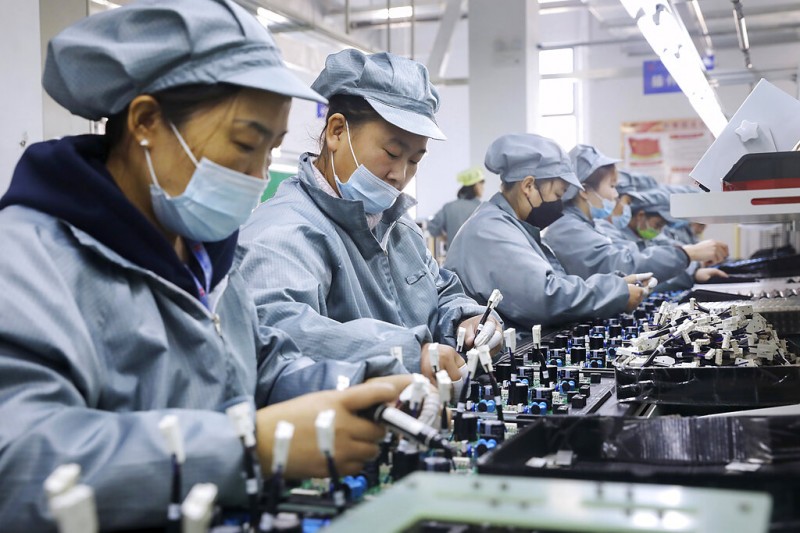China’s manufacturing industry is undergoing a transformative shift, embracing smart manufacturing technologies that combine automation, IoT, artificial intelligence (AI), and data analytics. These advancements are enabling factories to improve efficiency, reduce waste, and meet the growing global demand for high-quality, cost-effective products. With a robust infrastructure, government support, and an advanced supply chain, China is at the forefront of the global smart manufacturing revolution.
Core Features of Smart Manufacturing in China
1. Automated Production Lines
Automation is a cornerstone of smart manufacturing. Chinese factories increasingly employ robotic systems and advanced machinery to streamline production processes and eliminate inefficiencies.
- Example: In electronics manufacturing, surface mount technology (SMT) machines automate the placement of tiny components on PCBs with unmatched precision and speed.
- Impact: Automation reduces labor costs, minimizes human errors, and enhances product consistency. For instance, a smartphone manufacturer in Shenzhen integrated robotic arms into its assembly line, increasing production efficiency by 35% while cutting defects by 20%.
2. Real-Time Monitoring and Feedback
IoT sensors play a pivotal role in smart factories, providing real-time data on machine performance, production rates, and environmental conditions. This data enables predictive maintenance, optimized workflows, and immediate adjustments to production parameters.
- Application Example: A steel manufacturing plant in Wuhan installed IoT sensors to monitor furnace temperatures. These sensors instantly alert operators to temperature fluctuations, preventing material waste and reducing energy consumption by 15%.
3. AI-Driven Quality Control
Artificial intelligence enhances quality control by identifying defects and anomalies with higher accuracy and speed than manual inspections. AI systems analyze production data, such as images or sensor readings, to ensure products meet stringent quality standards.
- Example: A PCB factory in Suzhou employs AI-powered optical inspection systems to detect microscopic soldering defects. These systems process thousands of PCBs per hour with 99.9% accuracy, far outperforming human inspectors.
4. Flexible and Modular Manufacturing
Flexibility is a hallmark of smart factories, allowing manufacturers to quickly adapt to changing customer demands or produce multiple product lines on the same production floor.
- Example: A wearable electronics factory in Guangzhou uses modular manufacturing systems that can be reconfigured to produce different models of smartwatches without significant downtime. This approach reduces setup costs and improves responsiveness to market trends.
Key Factors Driving Smart Manufacturing in China
1. Government Support
The Chinese government has implemented several initiatives to promote smart manufacturing, such as the “Made in China 2025” plan, which aims to modernize the manufacturing sector and transition it to higher-value production.
- Subsidies and Incentives: Factories that adopt automation and digital technologies are eligible for government subsidies, tax breaks, and low-interest loans.
- Industrial Parks: Regions like Shenzhen and Suzhou have developed specialized industrial parks that provide infrastructure and resources for smart manufacturing companies.
2. 5G Connectivity
China’s rapid rollout of 5G networks has been a game-changer for smart manufacturing. The low latency and high bandwidth of 5G enable seamless communication between machines, sensors, and central control systems, enhancing the efficiency of IoT-based operations.
- Example: In an automotive factory in Shanghai, 5G-enabled robots coordinate in real time to assemble electric vehicle components, reducing production cycle times by 20%.
3. Access to Advanced Technology
Chinese factories benefit from access to cutting-edge technologies such as AI, robotics, and cloud computing. These technologies are increasingly integrated into production systems to optimize performance and enable advanced capabilities like predictive analytics and digital twins.
- Digital Twin Technology: Factories create digital replicas of physical systems to simulate production processes and test improvements before implementing changes. This reduces risks and accelerates innovation.
Applications of Smart Manufacturing in Key Industries
1. Electronics Manufacturing
China’s electronics factories are leading adopters of smart manufacturing, producing high-tech devices like smartphones, laptops, and IoT devices with unparalleled efficiency.
- AI and Robotics Integration: SMT machines and robotic arms handle the precise placement of micro-components, while AI-powered inspection systems ensure quality at every step.
- IoT-Driven Maintenance: Factories use IoT sensors to monitor equipment health, preventing costly breakdowns and minimizing downtime.
2. Automotive Production
The automotive industry in China is rapidly embracing smart manufacturing to meet the growing demand for electric vehicles (EVs) and autonomous driving systems.
- Battery Assembly: Automated production lines ensure consistent quality in EV battery packs, a critical component for safety and performance.
- 5G-Enabled Robots: Robots in assembly lines use real-time communication to coordinate tasks, enhancing precision and reducing cycle times.
3. Healthcare and Medical Devices
Manufacturers of medical devices and equipment are using smart manufacturing to meet stringent quality requirements while scaling production.
- Example: A medical device factory in Chengdu uses AI algorithms to analyze production data and ensure compliance with international standards for diagnostic equipment.
Benefits of Smart Manufacturing for International Buyers
For global buyers, sourcing products from smart factories in China offers several advantages:
1. Faster Turnaround Times
Smart factories can produce high volumes of products with reduced lead times. Automation and real-time data monitoring eliminate bottlenecks, allowing manufacturers to fulfill orders quickly.
- Example: A U.S.-based electronics retailer partnered with a smart factory in Shenzhen to produce custom-designed smart speakers. The factory’s modular production system enabled a 20% faster delivery compared to traditional facilities.
2. Enhanced Product Quality
AI-powered quality control ensures that products meet or exceed international standards, reducing the risk of defects and returns.
3. Competitive Pricing
While smart manufacturing involves upfront investments in technology, the long-term savings from reduced labor costs, improved efficiency, and minimal waste translate into more competitive pricing for buyers.
4. Sustainability
Smart factories prioritize resource efficiency, reducing energy consumption, material waste, and emissions. Buyers sourcing from such factories align with global sustainability goals and enhance their brand reputation.
Challenges and Strategies for Buyers
While smart manufacturing offers significant benefits, international buyers should be aware of potential challenges and adopt strategies to mitigate risks:
1. Identifying Reliable Smart Factories
Not all factories are equally advanced in their adoption of smart manufacturing technologies. Buyers should:
- Conduct factory audits to evaluate the level of automation and technology integration.
- Verify certifications like ISO 9001 for quality management and ISO 14001 for environmental management.
2. Ensuring Compatibility
Smart factories often use advanced tools and systems that may require compatibility with the buyer’s requirements. Clear communication about specifications and standards is essential.
3. Protecting Intellectual Property
With smart factories capable of rapid prototyping and production, buyers should implement non-disclosure agreements (NDAs) and monitor the production process to safeguard proprietary designs.
Case Study: A European Retailer’s Smart Factory Partnership
A European home appliance retailer sought to launch a new line of IoT-enabled washing machines. They partnered with a smart factory in Suzhou equipped with automated assembly lines and AI-driven quality control systems. The collaboration resulted in:
- A 30% reduction in production costs due to automation.
- A 25% faster time-to-market compared to the retailer’s previous suppliers.
- Near-zero defects in the initial production batch, thanks to AI-powered inspections.
This partnership highlights how buyers can leverage China’s smart manufacturing capabilities to gain a competitive edge.






